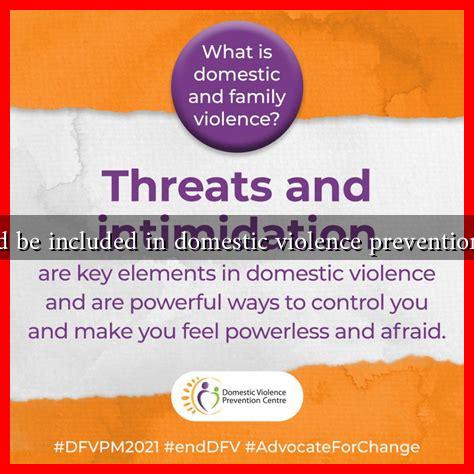-
Table of Contents
- What Should Be Included in Domestic Violence Prevention Programs?
- Understanding the Scope of Domestic Violence
- Key Components of Domestic Violence Prevention Programs
- 1. Education and Awareness Campaigns
- 2. Training for Professionals
- 3. Support Services for Victims
- 4. Community Engagement and Involvement
- 5. Policy Advocacy and Legal Reform
- Conclusion
What Should Be Included in Domestic Violence Prevention Programs?
Domestic violence is a pervasive issue that affects millions of individuals and families worldwide. According to the World Health Organization, approximately 1 in 3 women and 1 in 4 men have experienced physical or sexual violence from an intimate partner. To combat this alarming trend, effective domestic violence prevention programs are essential. This article explores the key components that should be included in these programs to ensure they are comprehensive, effective, and sustainable.
Understanding the Scope of Domestic Violence
Before delving into the specifics of prevention programs, it is crucial to understand the various forms of domestic violence. These can include:
- Physical abuse
- Emotional and psychological abuse
- Sexual abuse
- Financial abuse
- Stalking and harassment
Recognizing the multifaceted nature of domestic violence is vital for developing targeted prevention strategies.
Key Components of Domestic Violence Prevention Programs
Effective domestic violence prevention programs should encompass a variety of elements to address the issue holistically. Here are some essential components:
1. Education and Awareness Campaigns
Raising awareness about domestic violence is the first step in prevention. Educational campaigns can help individuals recognize the signs of abuse and understand the resources available to them. These campaigns should target:
- Schools and universities
- Community centers
- Workplaces
- Online platforms
For example, the “Love is Respect” campaign provides resources for young people to understand healthy relationships and recognize abusive behaviors.
2. Training for Professionals
Professionals who interact with victims of domestic violence, such as healthcare providers, law enforcement, and social workers, should receive specialized training. This training should cover:
- Identifying signs of abuse
- Understanding the dynamics of power and control
- Providing appropriate support and resources
Programs like the “Domestic Violence Training for Healthcare Providers” have shown success in equipping medical professionals with the skills needed to assist victims effectively.
3. Support Services for Victims
Providing accessible support services is crucial for victims seeking help. These services should include:
- Crisis hotlines
- Safe shelters
- Counseling and therapy
- Legal assistance
Organizations like the National Domestic Violence Hotline offer 24/7 support and resources for individuals in crisis.
4. Community Engagement and Involvement
Community involvement is essential for creating a supportive environment for victims. Programs should encourage:
- Community workshops and seminars
- Partnerships with local businesses and organizations
- Volunteer opportunities for community members
For instance, the “Men as Allies” initiative engages men in discussions about domestic violence, promoting a culture of respect and accountability.
5. Policy Advocacy and Legal Reform
Advocating for stronger laws and policies related to domestic violence is critical for long-term change. Prevention programs should include:
- Lobbying for stricter penalties for offenders
- Promoting policies that support victims, such as paid leave
- Encouraging law enforcement to adopt trauma-informed practices
Organizations like the National Network to End Domestic Violence work tirelessly to influence policy changes at the local, state, and national levels.
Conclusion
Domestic violence prevention programs must be multifaceted, addressing the issue from various angles to be effective. By incorporating education and awareness campaigns, professional training, support services, community engagement, and policy advocacy, these programs can create a safer environment for individuals at risk. As society continues to confront the realities of domestic violence, it is imperative that we invest in comprehensive prevention strategies that empower victims and hold abusers accountable. Together, we can work towards a future free from domestic violence.
For more information on domestic violence prevention, visit the National Coalition Against Domestic Violence.

